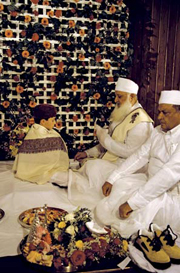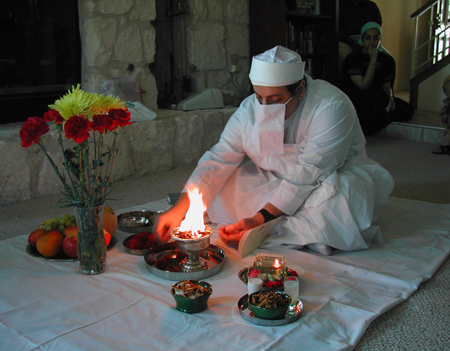Human Flower Project
Thursday, March 20, 2008
East of Easter – Zoroastrian
One of the oldest New Year celebrations on earth takes place today—the Navrooz—marked with flowers and fire.
 Zoroastrian priests perform a Jashan/rite to induct a young new member into the faith
Zoroastrian priests perform a Jashan/rite to induct a young new member into the faith
Photo: Tim Page
Today, March 20 (or yesterday, the 19th, depending on your continent) marks the Spring Equinox. For Zoroastrians around the globe, it is also the New Year, or Navrooz. We send special greetings to Ketty Wadia and the Zoroastrian community here in Austin, Texas, who back in 2003 kindly invited us to participate in their beautiful New Year’s celebration.
We were, of course, especially enthralled with the priest’s use of flowers in the Jashan/ceremony. As guests, young and old, all dressed in finery, sat around the edges of a North Austin livingroom, priest Khurshed Katki carried out the New Year’s ritual. It involved many set prayers, fire, and the gathering and placing of specific numbers of flowers in an array of bowls and dishes. This website offers some explicit directions for carrying out the “Parsi Version” of Jashan (the Parsis being those Zoroastrians who centuries ago fled Iran and settled in southwestern India).
The Norooz is celebrated today in Iran also – by Zoroastrians as well as other ethnic Persians. “Why has this festival survived? There have been major attempts by the Muslim rulers over the centuries to minimize it, ban it or get rid of it once and for all. The reasons for their failure should be sought in the spirit of this festival. Contrary to the Islamic traditions where death and martyrdom mark all the major rituals, No Ruz is a celebration of life.”
The presence of flowers confirms that.

Zoroastrian priest Khurshed Khatki performs the New Year’s Jashan
Austin, Texas, 2003
Photo: Human Flower Project
For those who would like to learn more of Zoroastrianism, called the world’s first “revealed religion,” there’s plenty to read. Having been around since 3000 B.C., this religious tradition—also strong on cosmology—has a rich history. Many religious historians contend that the Magi (“Three Wise Men”) who followed “the star” to discover the Christ Child were Zoroastrian astronomers.
Though the Zoroastrians comprise a tiny minority in India, they have made their mark, primarily in service to the poor. And they are making their beneficent mark here in Texas, too.
After the Jashan ceremony five years ago, we spun around asking questions about the types of flowers used, the meaning of fire, the reason for the priest’s white mask, the names of all the dishes about to be served… One dignified lady gently called us aside.
She said, gazing at us quite directly: “Paying attention to all of the things—how we use flowers, our food, our dress, our burial customs, you have failed to learn anything. Our religion is not in any of these things. We believe in good thought, good speech, good action. That’s it!”
So came a stiff spring wind, blowing off our little journalistic toupee. How embarrassing, and bracing. What a high standard to live by.




